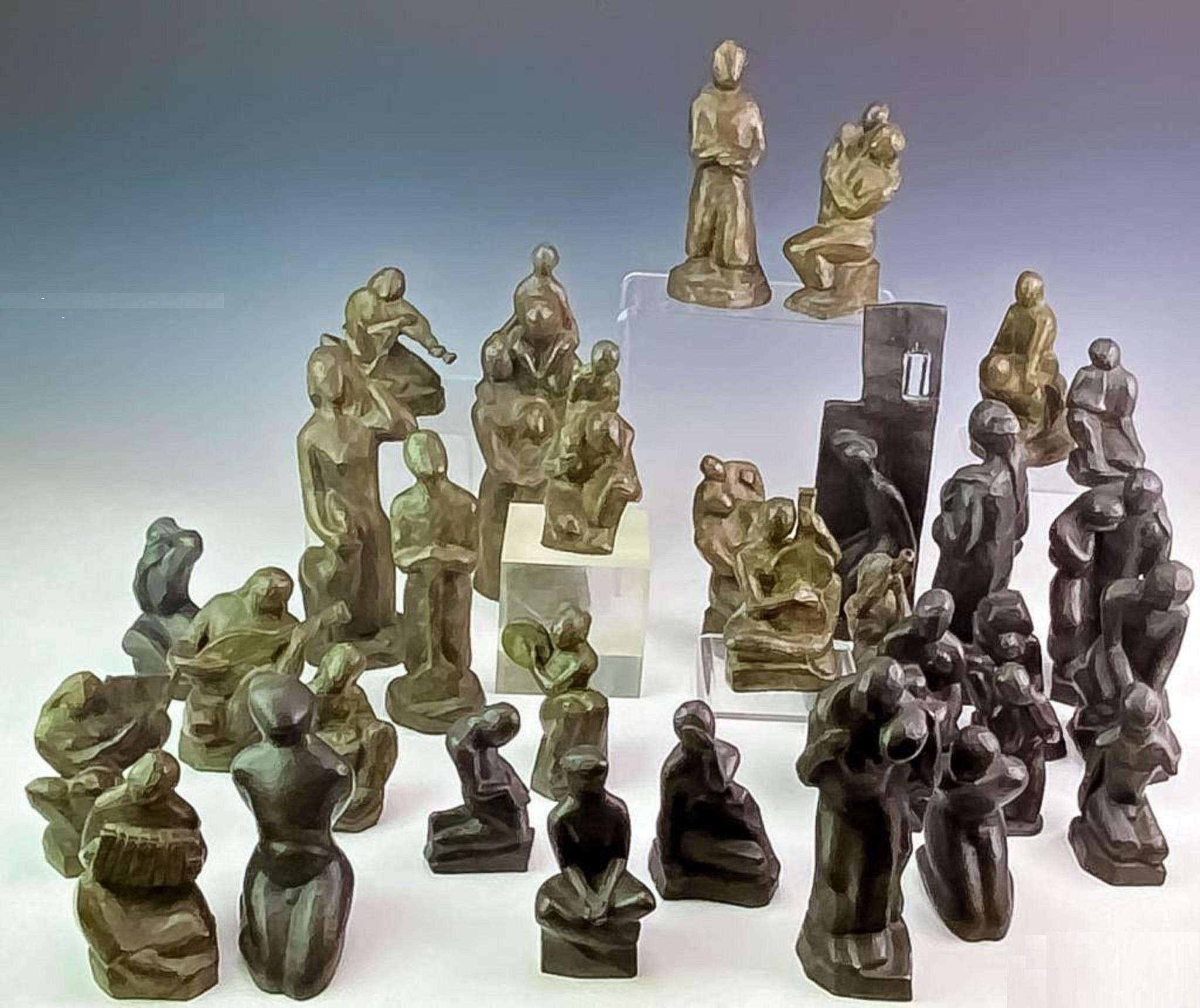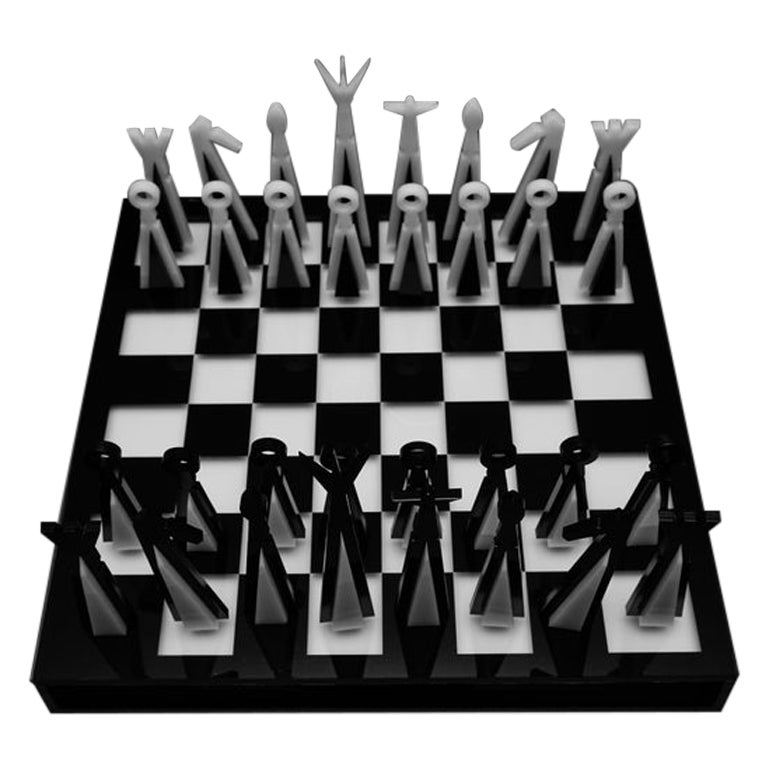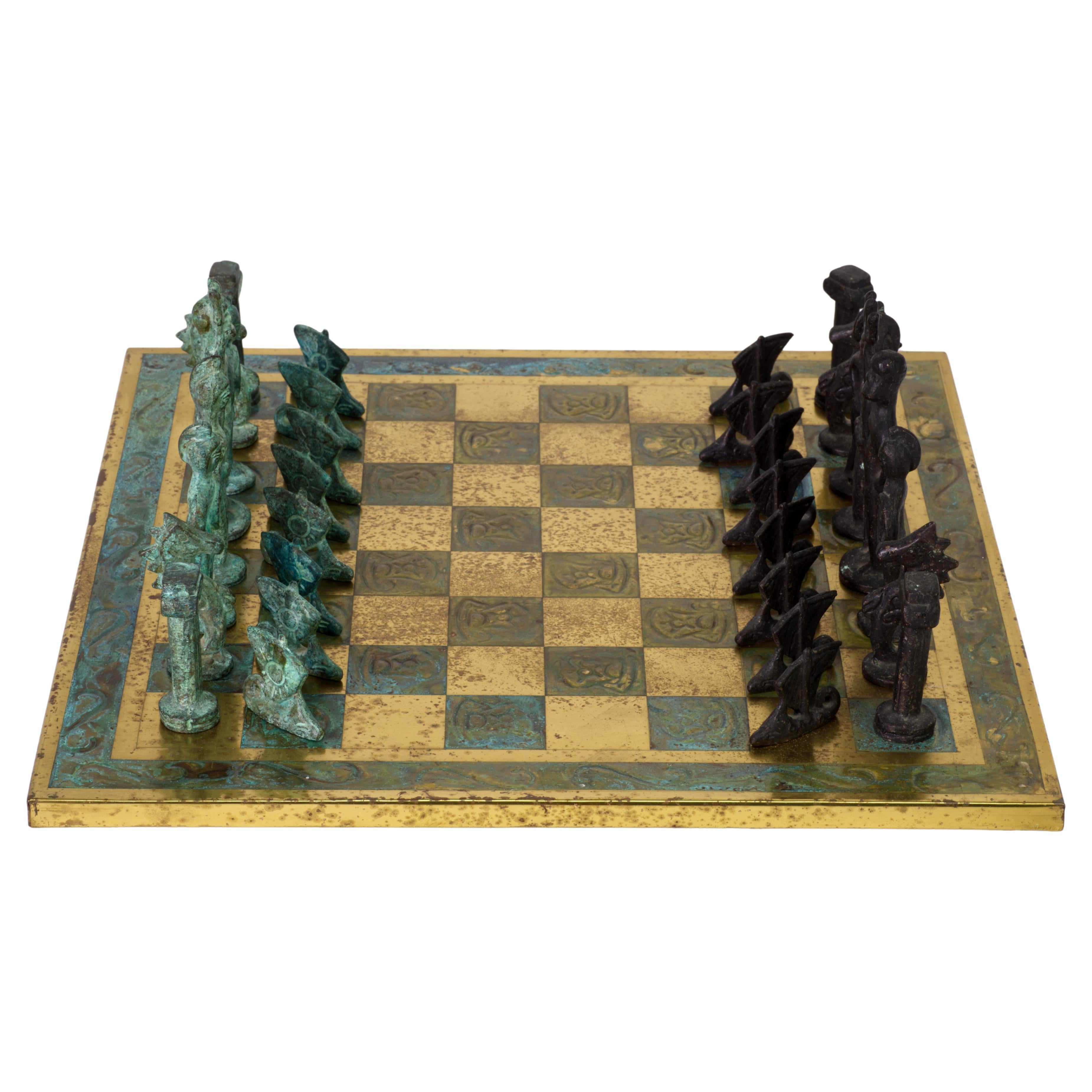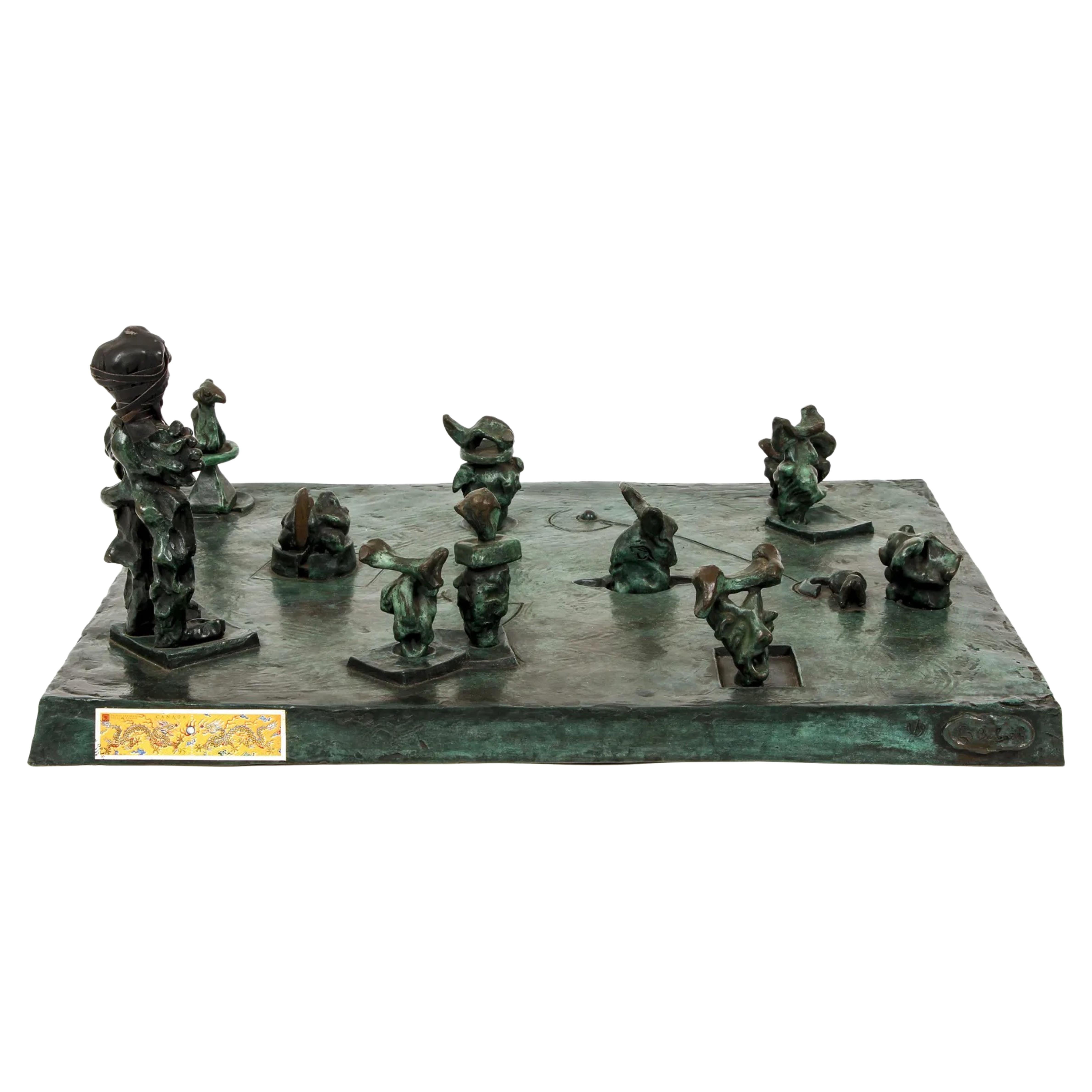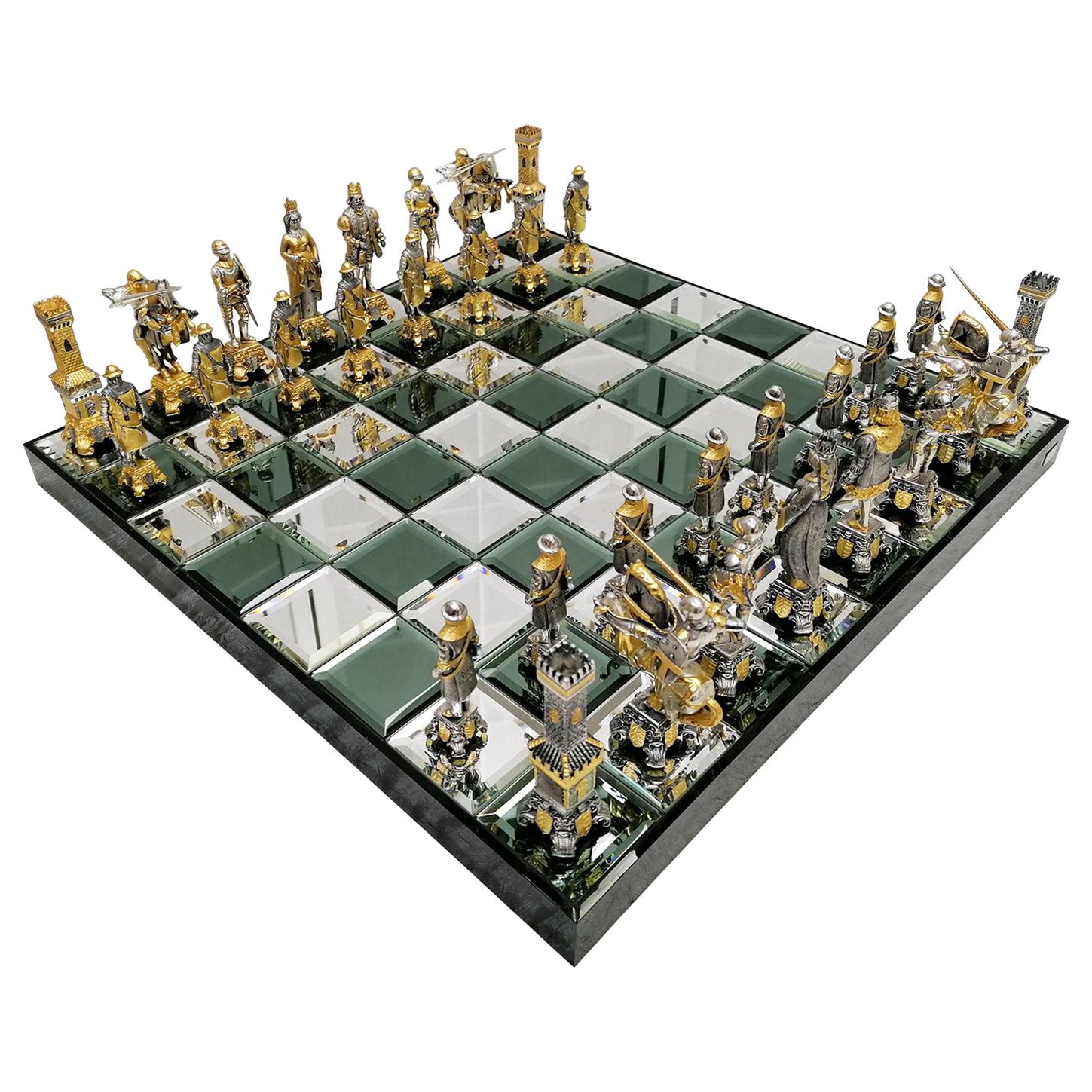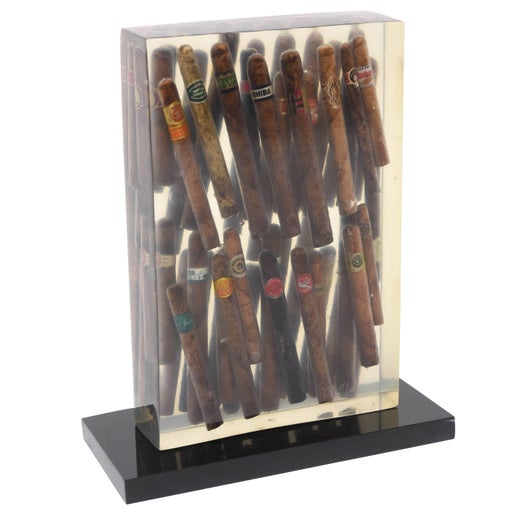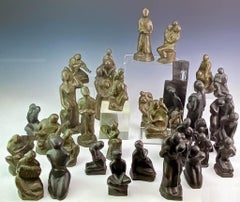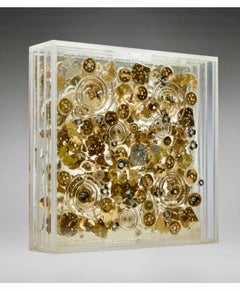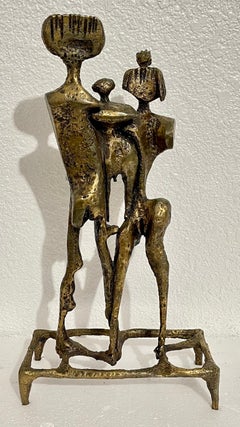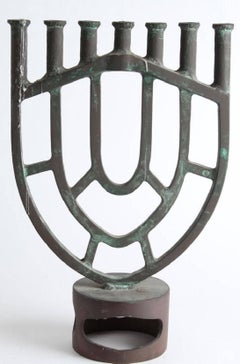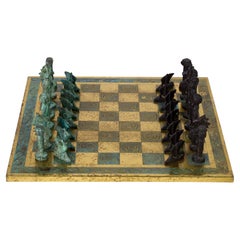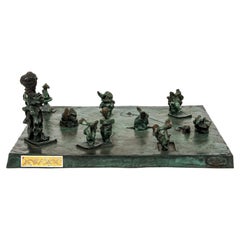Items Similar to French Pop Art Heavy Bronze Sculpture Chess Game Gambit Arman Accumulation
Want more images or videos?
Request additional images or videos from the seller
1 of 7
ArmanFrench Pop Art Heavy Bronze Sculpture Chess Game Gambit Arman Accumulation2003
2003
$18,000
£13,602.01
€15,706.98
CA$25,152.28
A$27,908.58
CHF 14,619.11
MX$342,234.07
NOK 185,950.08
SEK 175,528.94
DKK 117,136.80
Shipping
Retrieving quote...The 1stDibs Promise:
Authenticity Guarantee,
Money-Back Guarantee,
24-Hour Cancellation
About the Item
Arman, French American (1928-2005)
Gambit (Chess pieces)
Cast Bronze Sculpture with patina
Incised signature near lower edge, 48/70 with
impressed "Bronze Romain & Fils" foundry mark
Dimensions: (approximate) 17 X 13 X 12 inches
On a flat, square base, Chess pieces are sliced in half and placed in a asymmetrical, cubist manner that allows the viewer to examine the chess pieces from a variety of angles. The cutting also allows the interplay of the colors of the patinas: brown patina for the exterior of the pieces, verdigris patina for the interior of the pieces or bare bronze revealing the artist's cutting technique. Similar to the camera, violin, trumpet and sliced musical instruments that Arman is known for.
Gambit, Sculpture Bronze avec Patine Noire, Signature et Numéro Inscrire.
Arman (November 17, 1928 – October 22, 2005) was a French-born American artist. Born Armand Fernandez in Nice, France, Arman was a painter who moved from using objects for the ink or paint traces they leave ("cachet", "allures d'objet") to using them as the painting itself. He is best known for his "accumulations" and destruction/recomposition of objects. From his father, Arman learned oil painting and photography. After receiving his bachelor's degree in philosophy and mathematics in 1946, Arman began studying at the École Nationale des Arts Décoratifs in Nice. He also started judo at a police school in Nice where he met Yves Klein and Claude Pascal. The trio bonded closely on a subsequent hitch-hiking tour around Europe.
Early on, it was apparent that Arman's concept of the accumulation of vast quantities of the same objects was to remain a significant component of his art. Ironically, he had originally focused more attention on his abstract paintings, considering them to be of more consequence than his early accumulations of stamps. Only when he witnessed viewer reaction to his first accumulation in 1959 did he fully recognize the power of such art. In 1962, he began welding together accumulations of the same kinds of metal objects, such as axes. some of these works were then cast in bronze at Foundry Bocquel, He also made many prints in various techniques including lithograph, silkscreen and etching.
Inspired by an exhibition for the German Dadaist Kurt Schwitters in 1954, Arman began working on "Cachets," his first major artistic undertaking. At his third solo exhibition held in Paris's Galerie Iris Clert in 1958, Arman showed some of his first 2D accumulations he called "cachets." These stamps on paper and fabric proved a success and provided an important change of course for the young artist's career.
At the time, he was signing with his first name as an homage to Van Gogh, who also signed his works with his first name, "Vincent." And, thus, in 1957, Arman chose to change his name from Armand to Arman. On January 31, 1973, upon becoming a citizen of the United States, he took the American civil name, Armand Pierre Arman. Nevertheless, he continued to use "Arman" as his public persona.
In October 1960, Arman, Yves Klein, François Dufrêne, Raymond Hains, Martial Raysse, Daniel Spoerri, Jean Tinguely and Jacques Villeglé, and art critic and philosopher Pierre Restany founded the Nouveau réalisme group. Joined later by Cesar, Mimmo Rotella, Niki de Saint Phalle, and Christo, the group of young artists defined themselves as bearing in common their "new perspective approaches of reality." His work lies at the intersection of Pop art, fluxus and Dada sensibilities with a light dose of cubism. They were reassessing the concept of art and the artist for a 20th-century consumer society by reasserting the humanistic ideals in the face of industrial expansion.
Arman can be seen in the Andy Warhol film Dinner at Daley's, a documentation of a dinner performance by the Fluxus artist Daniel Spoerri that Warhol filmed on March 5, 1964. Throughout the portrait-screen-test film, Arman sits in profile, looking down, appearing to be entranced in his reading, seemingly unaware of Warhol's camera, only making small gestures, rubbing his eyes, and licking the corner of his mouth. He remained silent, eyes gazing over the pages of what seemed to be a newspaper, in this four-minute, 16mm black-and-white reel. Warhol owned two of Arman's Poubelles and another accumulation called Amphetamines, which were sold at Sotheby's auction of the Andy Warhol Collection in May 1988. He is known for his painting and sculpture in particular his assemblage and collage works.
Fascinated with the scene in New York, Arman took up part-time residency there from his home in Nice in 1961, after his first exhibition at the Cordier Warren Gallery. In the city, he met Marcel Duchamp at a dinner given by the artist and collector William Copley.
Arman often adopted destruction as a strategy for creation: He sliced, burned, and smashed objects such as bronze statues and musical instruments, then mounted fragments on canvas, encased them in resin or plexiglass, or presented them alone. In the 1960s, he was associated with Nouveau Réalisme—a European movement founded in response to American Pop art—along with close friend and fellow artist Yves Klein.
Arman exhibited extensively throughout his lifetime and received numerous awards. His work has sold for six figures at auction and belongs in the collections of the Museum of Modern Art, the Hirshhorn Museum and Sculpture Garden, the Tate, the Stedelijk Museum, and the Tel Aviv Museum of Art, among other institutions.
Selected exhibitions and awards
Arman, Stedelijk Museum, Amsterdam, Holland
Arman, Walker Art Center, Minneapolis, Minnesota
Arman, Palazzo Grassi, Venice, Italy
Musée des Arts Decoratifs, Paris, France; *Louisiana Museum of Modern Art Arman, Modern Art Museum, Stockholm, Sweden
Arman, Artcurial auction house, Paris, France
Arman: A Retrospective 1955 - 1991, The Brooklyn Museum, Brooklyn, New York; The Detroit Institute of Art, Detroit, Michigan
Arman, Musée du Jeu de Paume, Paris, France
Arman, Tel Aviv Museum of Art, Israel
Arman: Arman, Museum of Contemporary Art of Teheran, Teheran, Iran
Arman, Marlborough New York City
Arman, a retrospective, Centre Georges Pompidou, Oct. 2010, Paris
Arman, retrospective, Museum Tinguely, Feb. 2011, Basel, Switzerland
Arman-in les Baux de Provence, July-Oct. 2011, Les Baux-de-Provence
Paul Kasmin Gallery, New York
Public collections in the U.S.A., selected
Fine Arts Museums of San Francisco, California
Hirshhorn Museum and Sculpture Garden, Washington, D.C.
Harvard Art Museum, Cambridge, Massachusetts
The Detroit Institute of Arts, Detroit, Michigan
The Museum of Modern Art, New York
- Creator:Arman (1928 - 2005, French)
- Creation Year:2003
- Dimensions:Height: 17 in (43.18 cm)Width: 13 in (33.02 cm)Depth: 12 in (30.48 cm)
- Medium:
- Movement & Style:
- Period:
- Condition:very minor wear. please see photos.
- Gallery Location:Surfside, FL
- Reference Number:1stDibs: LU38214269512
Arman
Arman was born in Nice, France, in 1928, and showed a talent for painting and drawing as a child. He studied at the the Ecole Nationale des Art Décoratifs in Nice followed by studies at the École du Louvre in Paris. In his early years he focused on abstract paintings. Then, in 1957, he became interested in common objects as works of art. He first did what came to be called his "allures d"objet" (object impressions), where he would dip an object into paint and press it on canvas thus leaving the object's shadow or impression. Then he decided the object itself was worth paying attention to and started to treat them in his own way. His intention was to remove the material purpose of an object so that its only remaining function was to "feed the mind" as a work of art. What better way to achieve that result than by breaking, slicing or even burning objects such as violins, telephones, typewriters or even whole cars? He also made objects useless by accumulating them, such as 2,000 wristwatches in a Plexiglass box that all kept different time. Once emotionally detached from the circumstances associated with a broken object, the viewer could grow to appreciate its abstract beauty; so, in a sense, Arman was literally teaching that things one never thought could be regarded as attractive could indeed turn out to be so. Through this achievement, Arman gained worldwide recognition and is regarded as one of the most prolific and inventive creators of the late 20th century. His work can be found in the collections of numerous museums including the Metropolitan Museum of Art in New York, the Tate Gallery in London and the Centre Pompidou in Paris. Arman’s work has also been exhibited in galleries, museums and public spaces worldwide including the Musée D’Art Contemporain in Tehran, Iran; the Museum of Art in Tel Aviv, Israel; the Musée Des Arts Decoratifs and Opéra De Paris in France; the La Jolla Museum of Contemporary Art in California; and the Museum of Arts and Design and the Guggenheim in New York He died in 2005 in New York.
About the Seller
4.9
Platinum Seller
Premium sellers with a 4.7+ rating and 24-hour response times
Established in 1995
1stDibs seller since 2014
1,780 sales on 1stDibs
Typical response time: <1 hour
- ShippingRetrieving quote...Shipping from: Surfside, FL
- Return Policy
Authenticity Guarantee
In the unlikely event there’s an issue with an item’s authenticity, contact us within 1 year for a full refund. DetailsMoney-Back Guarantee
If your item is not as described, is damaged in transit, or does not arrive, contact us within 7 days for a full refund. Details24-Hour Cancellation
You have a 24-hour grace period in which to reconsider your purchase, with no questions asked.Vetted Professional Sellers
Our world-class sellers must adhere to strict standards for service and quality, maintaining the integrity of our listings.Price-Match Guarantee
If you find that a seller listed the same item for a lower price elsewhere, we’ll match it.Trusted Global Delivery
Our best-in-class carrier network provides specialized shipping options worldwide, including custom delivery.More From This Seller
View AllLiberty vs Slavery Van Loen Bronze Abstract Chess Set Modernist Museum Sculpture
By Alfred Van Loen
Located in Surfside, FL
Alfred Van Loen signed 32 piece chess set. In heavy solid bronze.
Rare Chess Game: Liberty versus Slavery
Dimensions:
a) Joy-Tenderness H. 6 3/16 in. a...
Category
1960s Expressionist Abstract Sculptures
Materials
Bronze
French Pop Art Assemblage Sculpture Watch Movements Temps 2 Arman Accumulation
By Arman
Located in Surfside, FL
Arman
Temps 2 (Mecanismes de montres)
1976
Accumulation of watch parts on three sheets of Plexiglas, encased in a box
Dimensions: 18.125 h × 18.125 w × 4.375 d in (46 × 46 × 11 cm)
H...
Category
1970s Abstract Figurative Sculptures
Materials
Metal
Large Aharon Bezalel Israeli Modernist Bronze Brutalist Puzzle Sculpture Figures
By Aharon Bezalel
Located in Surfside, FL
Aharon Bezalel (Afghani-Israeli, 1925-2012)
Family Grouping
Hand signed in with initials in English
Figures fit together like puzzle pieces in solid cast bronze with original patina.
Aharon Bezalel (born Afghanistan 1926) Born in Herat, Afghanistan in 1926 and immigrated to Israel at an early age. His father, Reuven Bezalel, was a rabbi and kabbalist. As a youth Aharon studied gold and silver casting as well as applied arts and worked in these fields as a silversmith and judaica craftsman, and was a student of the sculptor Zev Ben-Zvi at the Bezalel Academy for Art & Design where he also studied with Isidor Ascheim and Mordecai Ardon. There he absorbed the basic concepts of classic and modernist art and interpreted, according to them, ideas based on ancient Hebrew sources. He also studied miniature carving with the artists Martin and Helga Rost applying himself at their workshop. Aharon Bezalel worked and resided in Jerusalem, he taught art for many years. His sculptures - works of wood, bronze, aluminum, Plexiglas - were shown at his studio in Ein Kerem. “I saw myself as part of this region. I wanted to find the contact between my art and my surroundings. Those were the first years of Jean Piro’s excavations at the Beer-Sheba mound. They found there, for example, the Canaanite figurines that I especially liked and that were an element that connected me with the past and with this place.” “…a seed and sperm or male and female. These continue life. The singular, the individual alone, cannot exist; I learned this from my father who dabbled with the Kabbalah.”
(Aharon Bezalel, excerpt from an interview with David Gerstein)
“The singular in Aharon Bezalel’s work is always potentially a couple if not a threesome, the one is also the many: when the individual is revealed within the group he will always seek a huddling, a clinging together.
The principle of modular construction is required by this perception of unity and multiplicity, as modular construction in his work is an act of conception or defense. His work bears a similarity to Berrocal as well as affinities to Henry Moore, Lynne Chadwick and Kenneth Armitage. Two poles of unity, potentially alone, exist in A. Bezalel’s world: From a formal, sculptural sense these are the sphere and pillar, metaphorically these are the female in the final stages of pregnancy and the solitary male individual. Sphere-seed-woman; Pillar-strand-man. The disproportional, small heads in A. Bezalel figures leave humankind in it’s primal physical capacity. The woman as a pregnancy or hips, the man as an aggressive or defensive force, the elongated chest serves as a phallus and weapon simultaneously.
(Gideon Ofrat)
EIN HAROD About the Museum's Holdings: Israeli art is represented by the works of Reuven Rubin, Zaritzky, Nahum Gutman...
Category
Mid-20th Century Expressionist Abstract Sculptures
Materials
Bronze
Heavy Bronze Modernist Menorah Candelabra Sculpture
By Gloria Kisch
Located in Surfside, FL
hand signed on base. Judaica sculpture
Gloria Kisch
EDUCATION
Otis Art Institute, MFA, BFA. Boston Museum School. Sarah Lawrence College, BA.
MUSEUM SOLO EXHIBITIONS
Las Vegas Art Museum, Las Vegas, Nevada.
Bergen Museum of Art, Paramus, New Jersey.
Institute for Art and Urban Resources, PS1 Long Island City, New York.
Institute of Contemporary Art, Los Angeles, California.
Milwaukee Art Museum, Milwaukee, Wisconsin.
Newport Harbor Art Museum, Newport Beach, California. Queens Museum, Flushing, New York.
Installation, Longhouse Reserve, East Hampton, New York.
MUSEUM GROUP EXHIBITIONS
Review of Acquisitions Since 1980, Aldrich Museum, Ridgefield, Connecticut.
Recent International Forms in Art, Biennale of Sydney, Art Gallery of New South Wales, Sydney, Australia.
Whimsy in Art, Bergen Museum of Art, Paramus, New Jersey.
100th Anniversary Exhibition, Denver Art Museum, Denver, Colorado. Recent Acquisitions, Denver Art Museum, Denver, Colorado.
The Permanent Collection, Downey Museum of Art, Los Angeles, California.
Juried Exhibition, Fine Arts Gallery, San Diego, California.
Southern California Artists, Institute of Contemporary Art, Los Angeles, California. Made in LA: Prints of Cirrus Editions, Los Angeles County Museum of Art, Los Angeles, California.
The Other Things Artists Make, Los Angeles Municipal Gallery, Los Angeles, California. American Art, Centrum Sztuki Museum, Warsaw, Poland.
Painted Metal, City without Walls, Newark, New Jersey.
Painters of California, Palm springs Desert Art Museum, Palm springs, California.
Mirrors: Second Design Biennial, Parrish Art Museum, Southampton, New York. Kisch/Wenzel, Soho Center for Visual Artists, New York, New York.
Design for Living: Post War Furniture from the Permanent Collection, Virginia Museum of Fine Arts, Richmond, Virginia.
MUSEUM AND CORPORATE COLLECTIONS
Aldrich Museum of contemporary Art, Ridgefield, Connecticut.
Bergen Museum of Art, Paramus, New Jersey.
Centrum Sztuki Museum, Warsaw, Poland.
Los Angeles County Museum of Art, Los Angeles, California.
Mildura Art Museum, Melbourne, Australia.
Milwaukee Art Museum, Milwaukee, Wisconsin.
Neuberger Museum, Purchase, New York.
Newport Harbor Art Museum, Newport Beach, California.
Otis Art Institute, Los Angeles, California.
Palm Springs Desert Art Museum, Palm Springs, California.
Vassar college Art Museum, Poughkeepsie, New York.
Virginia Museum of Fine Arts, Richmond, Virginia.
Best Product Corporation, Richmond, Virginia. Community Bank, Holyoke, Massachusetts.
Equitable Corporation, New York, New York.
Hartz Mountain Industries, Secaucus, New Jersey. Security Pacific Bank, Los Angeles, California.
Soho Grand Hotel, New York, New York.
SELECTED GALLERY SOLO EXHIBITIONS
Art et Industrie, New York, New York.
Benson Gallery, Bridgehampton, New York.
California State University, Los Angeles, California. Cirrus Gallery, Los Angeles, California.
Donahue/Sosinski Art, New York, New York.
Janus Gallery...
Category
20th Century Modern Still-life Sculptures
Materials
Bronze
Brutalist Modern Abstract Bronze Sculpture Metropolis Manner of Louise Nevelson
By Abbott Pattison
Located in Surfside, FL
A very heavy, massive bronze sculpture by an important Chicago sculptor. Signed and marked "Firenze" with "Fuse Marinelli". METROPOLIS. Seven abstract shapes on black marble base. 1...
Category
20th Century Modern Abstract Sculptures
Materials
Marble, Bronze
Bronze Architectural Abstract Theater Model French Contemporary Sculpture
Located in Surfside, FL
Guillaume Couffignal (French b. 1964)
Theatre, 2014. Bronze.
19 7/8 x 13 1/2 x 7 1/4 inches.
Signed on the base: Couffignal. Beautiful texture and patina.
Guillaume Couffignal is a ...
Category
2010s Outsider Art Abstract Sculptures
Materials
Bronze
You May Also Like
Accumulation of Violins, bronze sculpture
By Arman
Located in Long Island City, NY
Accumulation of Violins
Arman, French (1928–2005)
Date: 1989
Bronze, signature and number inscribed
Edition of 37/99
Size: 13.25 x 6.5 x 6.5 in. (33.66 x 16.51 x 16.51 cm)
Category
1980s Pop Art Abstract Sculptures
Materials
Bronze
Price Upon Request
Chess / Silvino Lopeztovar
By Silvino Lopeztovar
Located in COYOACAN, DF
Silvino Lopeztovar
Born in Tlahuelilpan, Hidalgo, Mexico in 1970, Silvino Lopeztovar finished his professional design studies at the Universidad Nuevo Mundo in 1994. After his bachel...
Category
21st Century and Contemporary Mexican Other Abstract Sculptures
Materials
Acrylic
1960S Italian Chess set in Patinated Bronze.
Located in Clifton Springs, NY
Striking Italian bronze chess set was modeled after Etruscan bronze sculptures produced in the Umbro-Sabellian area around the 5th century BC. The figures are fully armored and read...
Category
Mid-20th Century Italian Brutalist Game Boards
Materials
Brass, Bronze
1984, Cast and Welded Bronze and Leather Sculpture by Artist Bob La Bobgah
Located in North Miami, FL
1984, cast and welded bronze and leather, by artist Bob La Bobgah. The piece is signed, numbered 1/9, and dated along the reverse back edge.
Category
20th Century American Abstract Sculptures
Materials
Brass, Bronze
20th Century Sculptural Italian Chess Game
By Arval Argenti Valenza
Located in VALENZA, IT
Brass chess board and chess game made with the ancient casting technique.
After casting, the finish was chiseled and subsequently silvered and finished with 24-carat gold plating.
The figures are in Florentine medieval style then painted with antioxidant treatment using a special transparent lacquer.
The two-tone mirrored glass chess top which highlights the high quality of execution.
Italian silverware, already with a centuries-old tradition, had a great development in the twentieth century and produced pieces of the highest quality that the whole world envies. Italian craftsmanship had a kind of new Renaissance after the war.
A great many high-quality silverware was born where exceptional pieces were produced that now decorate the most prestigious houses.
Made entirely by hand in the artisan workshop of piero Benzoni...
Category
Vintage 1980s Medieval Sheffield and Silverplate
Materials
Silver Plate
$5,671 Sale Price
20% Off
Chess Game "Kiriliuk Vs Kasparov" by Michel Kiriliuk
By Michel Kiriliuk
Located in Saint-Ouen, FR
Created in 2008
A unique and original work of art.
Engraved brass, metal and glass slab.
32 pieces made of silver engraves brass with a dark brown finish.
Sharkskin support
...
Category
Early 2000s European Game Tables
Materials
Metal, Brass
More Ways To Browse
Paris Art Bronze
Small French Sculpture
French Art Nouveau Sculpture
Mouth Sculpture
Bronze Face Sculpture
Sculpture Two Faces
Bronze Garden Sculpture
Art Nouveau Bronze Sculptures
Chess Game
Art Nouveau Bronze Germany
Chess Art
Welded Bronze Sculpture
Verdigris Sculpture
Dutch Art Nouveau
White Patina Bronze Sculpture
French Chess
Art Nouveau Iris
Chess Sculpture
